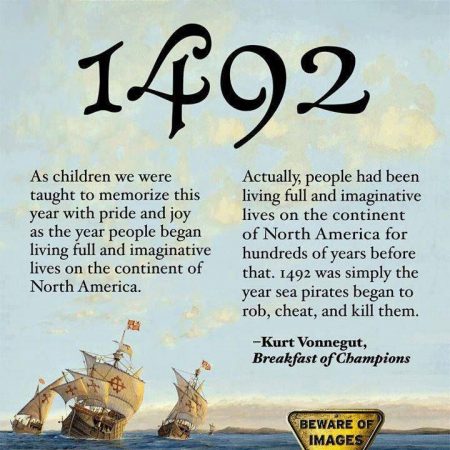August 23, 2017 – Why is a blog site devoted to writing about the future devoting a posting to what happened over 500 years ago? I have a history degree. That’s what I studied in university, and so I tend to look at science and technology by peering back in time as well as looking forward. And the two dates that strike me as a significant turning point in our human history and that of the planet are 1491 and 1492.
In 1491 North America was a blank on the maps drawn by Europeans. Then Christopher Columbus sailed across the North Atlantic and “discovered” an unknown populated world that he mistakenly thought was an outlier to the Asian continent. In time he and those who followed him realized that this was not an old, but a new world from the European context, certainly not viewed that way by those living in these new lands.
In 1492, therefore, the European impact on North and South America begins. And it is devastating. It marks the beginning of both a technological and biological invasion that leads to mass death for the inhabitants of these new found lands. It alters the biology of two continents, not just human, but other life as well. It hollows out two continents leading to the death of an estimated 50 million inhabitants in a period lasting a little over a century. The inhabitants of North and South America don’t just succumb to men in armor on horseback, some armed with guns, but rather to diseases for which they had no immunity.
When European colonists and explorers finally move inland from their Atlantic coastal settlements they discover largely empty-of-humans continents. Towns and villages, and fertile fields lie abandoned. The people are gone. They haven’t fled. They’ve died en masse. Cortez in Tenochtitlan doesn’t conquer the Aztecs. Disease does.
In terms of defined epochs created by geologists, the Holocene is the first in which modern humans are present. Holocene means recent. From a geological perspective, it covers from the end of the last Ice Age’s glacial maximum to the present, a period of approximately 11,500 years. This span of time includes the Neolithic Revolution when humans began domesticating plants and animals, and when we formed our first complex social groups settled in villages, towns, and cities.
Until recently we were all living in the Holocene. But not anymore. In the last few years, a number of scientists have been seeking a new definition for our times. The term, the Anthropocene, has emerged, defined as the period in the planet’s history when humans began leaving significant evidence of our impact on the planet, whether through things we have built, the mass extinctions we have caused, and the exploitation and degradation we have left in our wake.
But what date marks the beginning of the Anthropocene? In a paper published in Nature, two scientists, Simon Lewis, Leeds University in the United Kingdom, and Mark Maslin, University College London, have noted 1492 as a particularly meaningful date, marking the beginning of an unprecedented holocaust that would eventually run its course until the early 17th century, opening up two continents to European exploitation. States Lewis, “the collision of the Old and New Worlds marks the beginning of the modern world.”
Lewis and Maslin also describe an interesting consequence of the European impact on the planet over a century and a bit. Antarctic ice core records indicate that atmospheric carbon dioxide dipped between 1570 and 1620 by between 7 and 10 parts per million. They note that this is well above the margin of error that sometimes creeps into ice core analyses and speculate on whether human activity may have contributed to the decline.
Just how would that have worked out? If you consider the abandonment of large amounts of land under tillage by nearly 50 million North American inhabitants killed by exposure to European diseases, you can see a correlation. Between 1492 and 1650, the amount of land abandoned is estimated to have equaled 65 million hectares (160 million acres). Almost all reverted to forest and pasture. Add to that the reduction in human settlement activities such as cooking fires, and you have combined decline in carbon output as well as an increased natural carbon sink. Lewis and Maslin state that the decline in atmospheric carbon “is consistent with uptake by vegetation following the population crash in the Americas.”
That pushes the dates for the Anthropocene back from the currently accepted beginning in the mid-20th century to the year of the beginning of the European impact on both American continents: 1492.
















